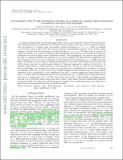AN INSTABILITY DUE TO THE NONLINEAR COUPLING OF p-MODES TO g-MODES: IMPLICATIONS FOR COALESCING NEUTRON STAR BINARIES
Author(s)
Weinberg, Nevin N.; Arras, Phil; Burkart, Joshua
DownloadWeinberg_An instability.pdf (770.8Kb)
OPEN_ACCESS_POLICY
Open Access Policy
Creative Commons Attribution-Noncommercial-Share Alike
Terms of use
Metadata
Show full item recordAbstract
A weakly nonlinear fluid wave propagating within a star can be unstable to three-wave interactions. The resonant parametric instability is a well-known form of three-wave interaction in which a primary wave of frequency ω [subscript a] excites a pair of secondary waves of frequency ω [subscript b] + ω [subscript c] [~ over bar] ω [subscript a]. Here we consider a nonresonant form of three-wave interaction in which a low-frequency primary wave excites a high-frequency p-mode and a low-frequency g-mode such that ω [subscript b] + ω [subscript c] >> ω [subscript a]. We show that a p-mode can couple so strongly to a g-mode of similar radial wavelength that this type of nonresonant interaction is unstable even if the primary wave amplitude is small. As an application, we analyze the stability of the tide in coalescing neutron star binaries to p-g mode coupling. We find that the equilibrium tide and dynamical tide are both p-g unstable at gravitational wave frequencies f [subscript gw] [> over ~] 20 Hz and drive short wavelength p-g mode pairs to significant energies on very short timescales (much less than the orbital decay time due to gravitational radiation). Resonant parametric coupling to the tide is, by contrast, either stable or drives modes at a much smaller rate. We do not solve for the saturation of the p-g instability and therefore we cannot say precisely how it influences the evolution of neutron star binaries. However, we show that if even a single daughter mode saturates near its wave breaking amplitude, the p-g instability of the equilibrium tide will (1) induce significant orbital phase errors (Δφ [> over ~] 1 radian) that accumulate primarily at low frequencies (f [subscript gw] [< over ~] 50 Hz) and (2) heat the neutron star core to a temperature of T ~ 10[superscript 10] K. Since there are at least ~100 unstable p-g daughter pairs, Δφ and T are potentially much larger than these values. Tides might therefore significantly influence the gravitational wave signal and electromagnetic emission from coalescing neutron star binaries at much larger orbital separations than previously thought.
Date issued
2013-05Department
Massachusetts Institute of Technology. Department of PhysicsJournal
The Astrophysical Journal
Publisher
IOP Publishing
Citation
Weinberg, Nevin N., Phil Arras, and Joshua Burkart. “AN INSTABILITY DUE TO THE NONLINEAR COUPLING OF p-MODES TO g-MODES: IMPLICATIONS FOR COALESCING NEUTRON STAR BINARIES.” The Astrophysical Journal 769, no. 2 (June 1, 2013): 121.
Version: Original manuscript
ISSN
0004-637X
1538-4357